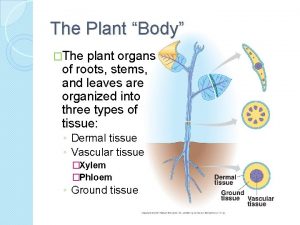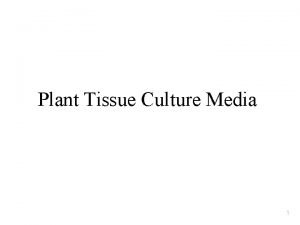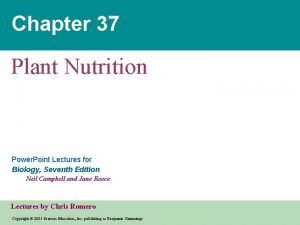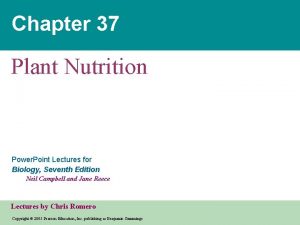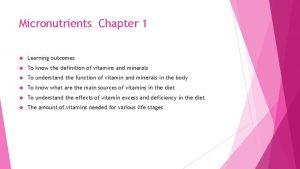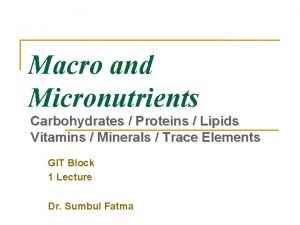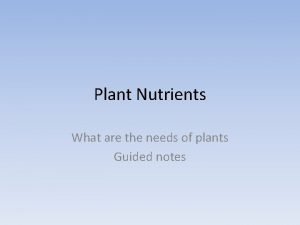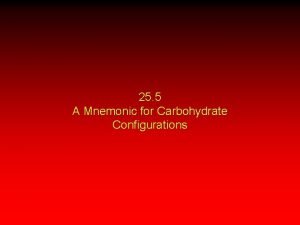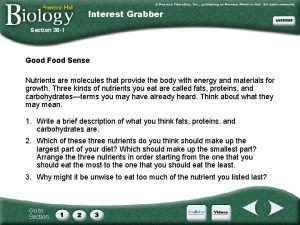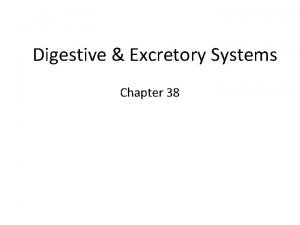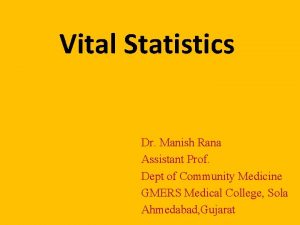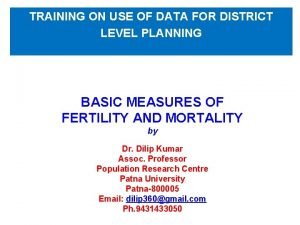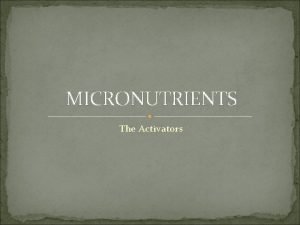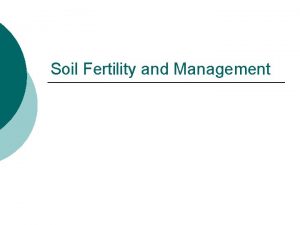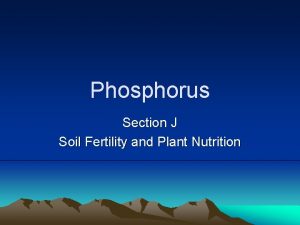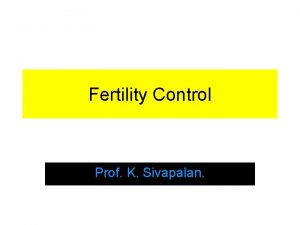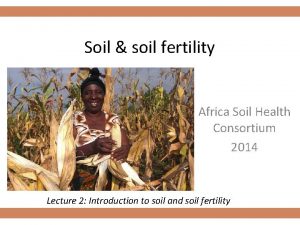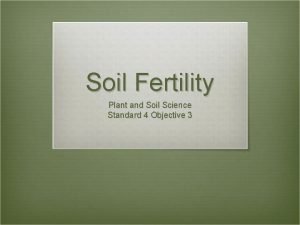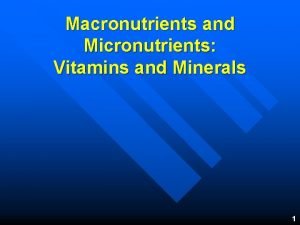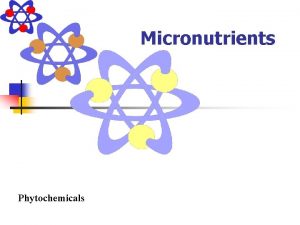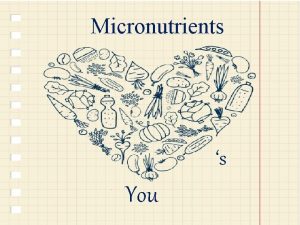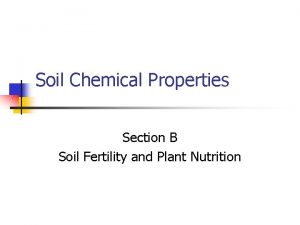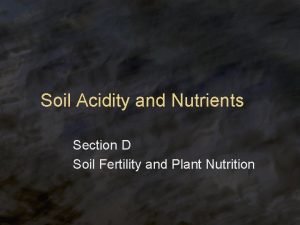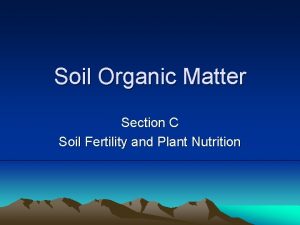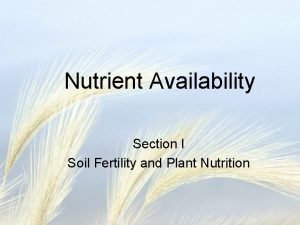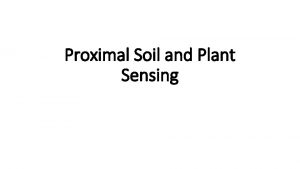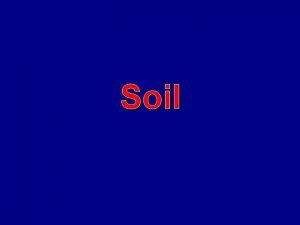Micronutrients Section N Soil Fertility and Plant Nutrition





























- Slides: 29

Micronutrients Section N Soil Fertility and Plant Nutrition


Micronutrients in Plants • Transition metal micronutrients: Fe, Mn, Zn, Cu, Mo, Ni - are important as enzyme cofactors, metal components of enzymes, and in electron transfer reactions. Immobile in plants. • Non-metal micronutrients B - important for cell division, meristematic tissue. Immobile in most plants. Cl - important for osmotic regulation. Mobile in plants.

Micronutrient Mobility • In plants: – With the exception of Cl, all micronutrients are immobile in plants. However, remember about B? – Significance? • In soils: – All except Cl are immobile in most soils.

Deficiencies Mn - lemon Mn - pecan

Manganese • Manganese activates many enzymes including metabolism, energy transport and fatty acid synthesis.

Deficiencies Zn - pecan Zn - corn Zn - citrus

Zinc • Zinc as manganese activates many enzymes. It is also essential for synthesis of auxin, a key hormone controlling cell growth.

Iron • Iron plays a function in photosynthesis.

Deficiencies Fe - beans Fe - peanuts

Deficiencies Mo - cauliflower

Boron • The function of boron in plants is not well understood. It is involved in carbohydrate transport, and cell membrane and cell wall development

Deficiencies B - cauliflower B - alfalfa B-canola

Micronutrients in Soils • Transition metals – occur mostly in primary and secondary minerals. Fe is the most abundant. Abundance of Fe increases as soils weather. Zn deficiency is the most widespread of micronutrient deficiencies. • B – Occurs in SOM (50%) and in minerals such as borates. Is most common in arid soils. • Cl – Most abundant in arid soils and near coasts

Incidence of Zn Deficiency http: //www. iza. com

Chemical Availability • Available Nutrient forms Cl B Mo Fe Mn Zn Cu Cl. H 3 BO 3 Mo. O 42 Fe 2+, Fe 3+ Mn 2+, Mn 3+ Zn 2+ Cu 2+, Cu+

Availability • Most important factors influencing availability of micronutrients: Soil texture (clay content) Degree of soil weathering p. H - most important Redox potential (aerobic vs. anaerobic). Fe, Mn, Cu much more available under anaerobic conditions.



Effects of Redox on Availability • Availability of Fe, Mn, Cu are directly affected by redox – Under anaerobic conditions, Fe, Mn, and Cu become more availability – Can become toxic, particularly Mn Mn toxicity

Deficiencies of Micronutrients • Conditions most likely to result in deficiencies of: – Fe, Mn, Cu, Zn, Ni: • Weathered, sandy soils. • Alkaline, aerobic soils. Cu deficiency likely in organic soil – Mo • Weathered, acid soils and sandy soils –B • Weathered, acid soils and sandy soils – Cl • Weathered, acid soils far from seacoasts


Differences Among Plants • Some plants are adapted to conditions of low micronutrient availability and rarely suffer deficiency: – Ability to change the rhizosphere p. H and redox to increase nutrient availability. – e. g. some roots secrete enzymes called phytosiderophores to increase Fe availability.

Fertilizing with Micronutrients • In alkaline soils, Fe, Mn, Cu, and Zn may react readily with soil constituents, rendering them insoluble and unavailable. – Therefore, use either chelated nutrients for soil application, or foliar applications of salt solutions. – B - use borate materials. Over-fertilization with B can cause toxicities – Cl - fertilizers are rarely used

Chelated (EDDHA)-Fe

Fe-EDTA

Chelate Mode of Action • Applying Fe fertilizer to an alkaline soil: Fe 3+ + 3 OH(available) Fe. OOH + H 2 O (unavailable) Applying Fe chelate to an alkaline soil: Fe-Ch + 3 OH(available) Fe. OOH + Ch 3 - + H 2 O (unavailable)

Micronutrients • Threshold between deficiency and toxicity narrow. • Efficiency of utilization for metal micronutrients a challenge due to soil reaction. • Often used where not needed. • Periodically needed and not used. • Fine tuning required in most areas substantial research required in a few.

Summary - Micronutrients • Most important factors influencing micronutrient availability in soils: – p. H, redox, weathering, texture • Most micronutrients are immobile in soils and plants – Diagnosis, treatment • Metal micronutrients are normally applied as chelates or by foliar application.
 Dr nutrition
Dr nutrition Macronutrients and micronutrients in plants
Macronutrients and micronutrients in plants Auxin in tissue culture
Auxin in tissue culture Macronutrients and micronutrients in plants
Macronutrients and micronutrients in plants Macronutrients and micronutrients in plants
Macronutrients and micronutrients in plants Macronutrients and micronutrients
Macronutrients and micronutrients Function of vitamins
Function of vitamins Pvt tim hall
Pvt tim hall Fixnaad
Fixnaad Mnemonic for micronutrients
Mnemonic for micronutrients 7 micronutrients
7 micronutrients Micronutrients
Micronutrients Mnemonic to remember micronutrients
Mnemonic to remember micronutrients Living soil vs dead soil
Living soil vs dead soil What are the four spheres of the earth
What are the four spheres of the earth Section 38-1 food and nutrition answer key
Section 38-1 food and nutrition answer key Section 38-1 food and nutrition
Section 38-1 food and nutrition Chapter 38 digestive and excretory systems
Chapter 38 digestive and excretory systems Tronsmo plant pathology and plant diseases download
Tronsmo plant pathology and plant diseases download Tronsmo plant pathology and plant diseases download
Tronsmo plant pathology and plant diseases download Albugo eye
Albugo eye Soil profile is a vertical cross section
Soil profile is a vertical cross section Sem vi
Sem vi Plant introduction in plant breeding
Plant introduction in plant breeding Plant introduction in plant breeding
Plant introduction in plant breeding Total fertility rate formula
Total fertility rate formula Asfr formula
Asfr formula Obando fertility rites place of origin
Obando fertility rites place of origin Birth rate problem
Birth rate problem Rumus egfr
Rumus egfr

